Gautham Vinod
MFP3D: Monocular Food Portion Estimation Leveraging 3D Point Clouds
Nov 14, 2024
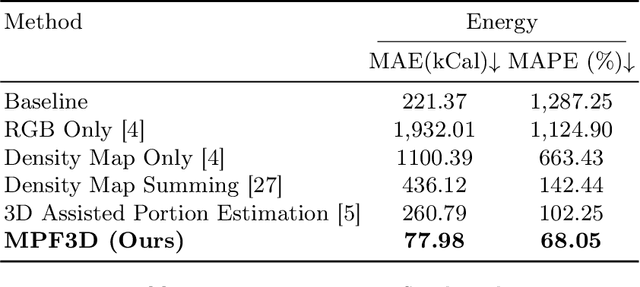
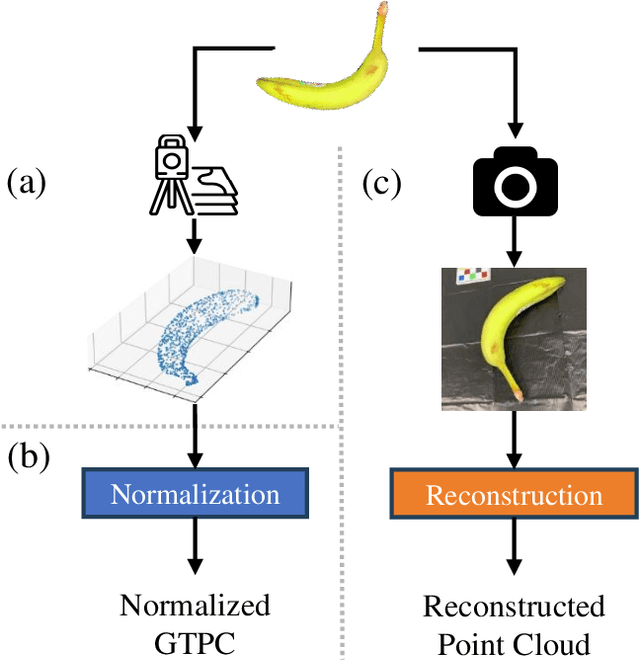
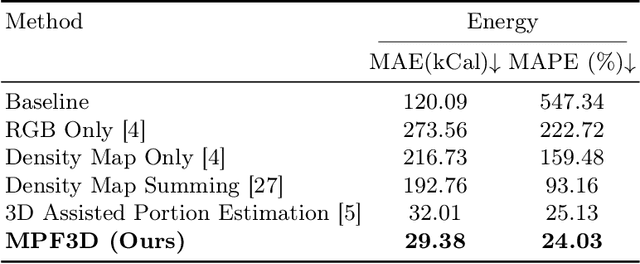
Abstract:Food portion estimation is crucial for monitoring health and tracking dietary intake. Image-based dietary assessment, which involves analyzing eating occasion images using computer vision techniques, is increasingly replacing traditional methods such as 24-hour recalls. However, accurately estimating the nutritional content from images remains challenging due to the loss of 3D information when projecting to the 2D image plane. Existing portion estimation methods are challenging to deploy in real-world scenarios due to their reliance on specific requirements, such as physical reference objects, high-quality depth information, or multi-view images and videos. In this paper, we introduce MFP3D, a new framework for accurate food portion estimation using only a single monocular image. Specifically, MFP3D consists of three key modules: (1) a 3D Reconstruction Module that generates a 3D point cloud representation of the food from the 2D image, (2) a Feature Extraction Module that extracts and concatenates features from both the 3D point cloud and the 2D RGB image, and (3) a Portion Regression Module that employs a deep regression model to estimate the food's volume and energy content based on the extracted features. Our MFP3D is evaluated on MetaFood3D dataset, demonstrating its significant improvement in accurate portion estimation over existing methods.
MetaFood3D: Large 3D Food Object Dataset with Nutrition Values
Sep 03, 2024Abstract:Food computing is both important and challenging in computer vision (CV). It significantly contributes to the development of CV algorithms due to its frequent presence in datasets across various applications, ranging from classification and instance segmentation to 3D reconstruction. The polymorphic shapes and textures of food, coupled with high variation in forms and vast multimodal information, including language descriptions and nutritional data, make food computing a complex and demanding task for modern CV algorithms. 3D food modeling is a new frontier for addressing food-related problems, due to its inherent capability to deal with random camera views and its straightforward representation for calculating food portion size. However, the primary hurdle in the development of algorithms for food object analysis is the lack of nutrition values in existing 3D datasets. Moreover, in the broader field of 3D research, there is a critical need for domain-specific test datasets. To bridge the gap between general 3D vision and food computing research, we propose MetaFood3D. This dataset consists of 637 meticulously labeled 3D food objects across 108 categories, featuring detailed nutrition information, weight, and food codes linked to a comprehensive nutrition database. The dataset emphasizes intra-class diversity and includes rich modalities such as textured mesh files, RGB-D videos, and segmentation masks. Experimental results demonstrate our dataset's significant potential for improving algorithm performance, highlight the challenging gap between video captures and 3D scanned data, and show the strength of the MetaFood3D dataset in high-quality data generation, simulation, and augmentation.
MetaFood CVPR 2024 Challenge on Physically Informed 3D Food Reconstruction: Methods and Results
Jul 12, 2024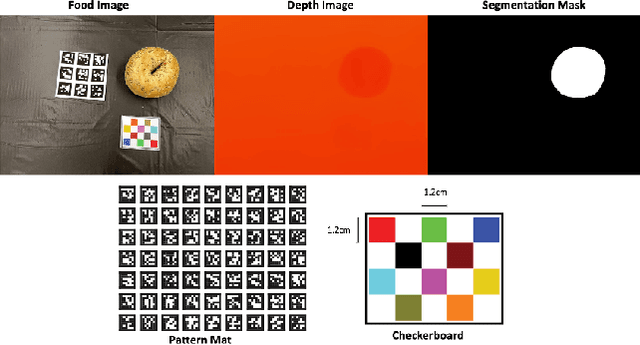
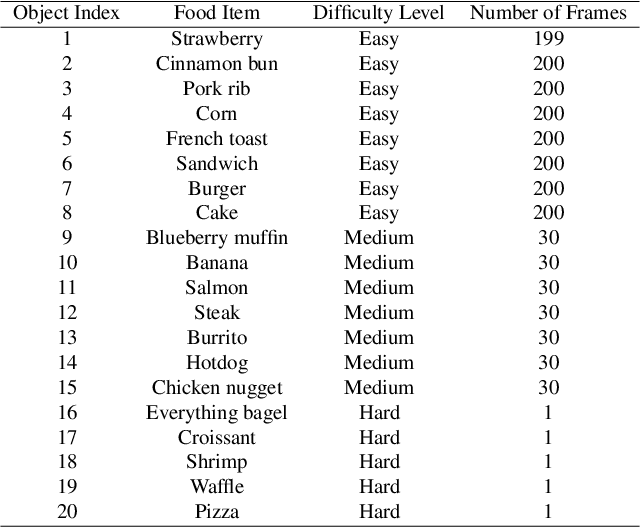
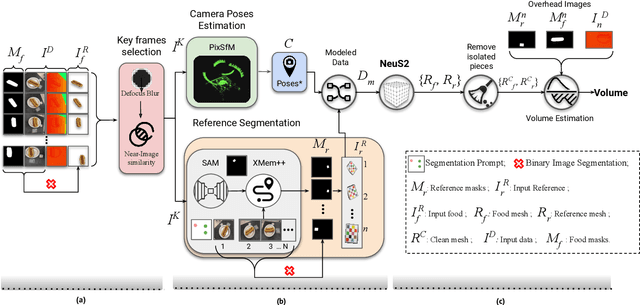
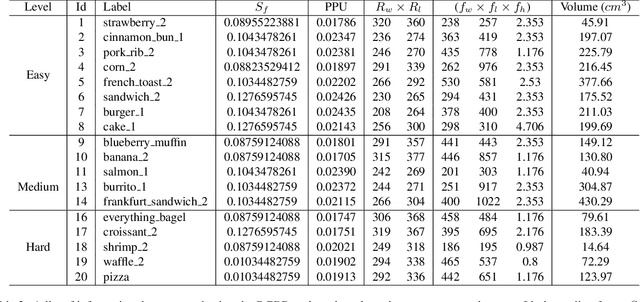
Abstract:The increasing interest in computer vision applications for nutrition and dietary monitoring has led to the development of advanced 3D reconstruction techniques for food items. However, the scarcity of high-quality data and limited collaboration between industry and academia have constrained progress in this field. Building on recent advancements in 3D reconstruction, we host the MetaFood Workshop and its challenge for Physically Informed 3D Food Reconstruction. This challenge focuses on reconstructing volume-accurate 3D models of food items from 2D images, using a visible checkerboard as a size reference. Participants were tasked with reconstructing 3D models for 20 selected food items of varying difficulty levels: easy, medium, and hard. The easy level provides 200 images, the medium level provides 30 images, and the hard level provides only 1 image for reconstruction. In total, 16 teams submitted results in the final testing phase. The solutions developed in this challenge achieved promising results in 3D food reconstruction, with significant potential for improving portion estimation for dietary assessment and nutritional monitoring. More details about this workshop challenge and access to the dataset can be found at https://sites.google.com/view/cvpr-metafood-2024.
Food Portion Estimation via 3D Object Scaling
Apr 18, 2024



Abstract:Image-based methods to analyze food images have alleviated the user burden and biases associated with traditional methods. However, accurate portion estimation remains a major challenge due to the loss of 3D information in the 2D representation of foods captured by smartphone cameras or wearable devices. In this paper, we propose a new framework to estimate both food volume and energy from 2D images by leveraging the power of 3D food models and physical reference in the eating scene. Our method estimates the pose of the camera and the food object in the input image and recreates the eating occasion by rendering an image of a 3D model of the food with the estimated poses. We also introduce a new dataset, SimpleFood45, which contains 2D images of 45 food items and associated annotations including food volume, weight, and energy. Our method achieves an average error of 31.10 kCal (17.67%) on this dataset, outperforming existing portion estimation methods.
An End-to-end Food Portion Estimation Framework Based on Shape Reconstruction from Monocular Image
Aug 03, 2023



Abstract:Dietary assessment is a key contributor to monitoring health status. Existing self-report methods are tedious and time-consuming with substantial biases and errors. Image-based food portion estimation aims to estimate food energy values directly from food images, showing great potential for automated dietary assessment solutions. Existing image-based methods either use a single-view image or incorporate multi-view images and depth information to estimate the food energy, which either has limited performance or creates user burdens. In this paper, we propose an end-to-end deep learning framework for food energy estimation from a monocular image through 3D shape reconstruction. We leverage a generative model to reconstruct the voxel representation of the food object from the input image to recover the missing 3D information. Our method is evaluated on a publicly available food image dataset Nutrition5k, resulting a Mean Absolute Error (MAE) of 40.05 kCal and Mean Absolute Percentage Error (MAPE) of 11.47% for food energy estimation. Our method uses RGB image as the only input at the inference stage and achieves competitive results compared to the existing method requiring both RGB and depth information.
Image Based Food Energy Estimation With Depth Domain Adaptation
Aug 25, 2022



Abstract:Assessment of dietary intake has primarily relied on self-report instruments, which are prone to measurement errors. Dietary assessment methods have increasingly incorporated technological advances particularly mobile, image based approaches to address some of these limitations and further automation. Mobile, image-based methods can reduce user burden and bias by automatically estimating dietary intake from eating occasion images that are captured by mobile devices. In this paper, we propose an "Energy Density Map" which is a pixel-to-pixel mapping from the RGB image to the energy density of the food. We then incorporate the "Energy Density Map" with an associated depth map that is captured by a depth sensor to estimate the food energy. The proposed method is evaluated on the Nutrition5k dataset. Experimental results show improved results compared to baseline methods with an average error of 13.29 kCal and an average percentage error of 13.57% between the ground-truth and the estimated energy of the food.
 Add to Chrome
Add to Chrome Add to Firefox
Add to Firefox Add to Edge
Add to Edge